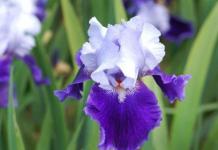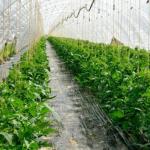They have long gained popularity due to their unusual appearance and unpretentiousness. They practically do not require care, even an inexperienced gardener can cope with growing. Many varieties of this plant have been bred. In order not to get confused in such a variety, it is necessary to study in advance irises, varieties with photos and names. This will help create a spectacular garden to the envy of all neighbors.
Varieties of irises
Iris is a perennial unpretentious plant, which is distinguished by an unusual shape and color of flowers. It is suitable for growing in open areas flooded with sunlight. A distinctive feature of the flowers is their charming delicate aroma. Therefore, they are often used in the perfume industry.
Wild-growing irises today can be found in meadows, in the steppe or on sheer cliffs. Under the conditions, about five hundred different varieties have been bred that are suitable for growing in personal plots. They can be divided into several large groups:
- bearded;
- dwarf;
- bulbous;
- Siberian;
- marsh;
- Japanese.
In European countries, it is customary to divide these plants into 10 - 15 categories. Separately, border, Californian and some other species are distinguished. To decide which of them will take root better on your site, carefully study the irises, their varieties with photos and names.
bearded irises
Iris bearded is considered one of the most common varieties of plants. Its distinguishing feature is the presence of fine hairs on the lower petals. They have a more saturated color compared to the general tone of the flower. Among the most spectacular varieties are:
This is just a small part of the variety on the market today. When choosing, pay attention to the fact that the flowers are in harmony with neighboring specimens and fit into the overall design of the site.
The height of such varieties can reach 80 cm, so you should not plant them in close proximity to photophilous low-growing plants.
dwarf irises
Iris dwarf differs from its counterparts in its small stature. The height of the peduncles does not exceed 40 cm. For most varieties, this parameter is 20 cm at all. They will be ideal for decorating small compact flower beds. Among the most popular varieties are:

Dwarf irises do well in light, permeable soils. If the soil in your garden is heavy, then add sand to it before planting.
bulbous irises
Everyone is used to the fact that irises are rhizomatous plants. Modern specialists have managed to breed several varieties growing from bulbs. They are distinguished by unusually early flowering. They can be compared to snowdrops. As soon as the snow melts, the first flowers appear. There are three main types:

Bulbous irises look good in a flower bed with crocuses, galanthus and so on. They will be ideal for alpine slides.
Such varieties can be grown in pots and large planters. They will be an excellent decoration of verandas and arbors.
Siberian irises
Photos of Siberian irises are impressive. They are distinguished by the extraordinary beauty of the flowers. The value of this species is also in the fact that the foliage of the plant has a rich green color throughout the season. The most spectacular varieties are:

Such varieties look spectacular along the banks of improvised reservoirs, in large ones. Groups of such flowers can decorate the lawn, which will give the landscape an unusual look.
swamp irises
Iris marsh or iris grows everywhere in our country. The leaves of this species are sword-shaped. Their length can reach two meters. This species does well in partial shade. Therefore, such flowers can be planted along fences or near trees with a not too dense crown. Among the most popular varieties are:

Having studied these varieties of irises with photos and names, we can conclude that they are ideal for group plantings. With the help of different types of irises, you can create spectacular flower beds.
Japanese irises
Japanese iris has orchid-shaped flowers. Their size can vary from 15 to 25 cm. In Japan, such plants are planted so that they can be admired from a height. From this angle, they look the most impressive.
The plants are large, so when planting between them, it is necessary to maintain a distance of at least 30 cm. The most popular varieties:

After studying the photo of the varieties of irises, you can choose the right planting material that is suitable for your type of soil. If you choose specimens with different flowering periods, you can admire the beauty of flowers all summer long.
Irises bloom in the garden - video
Irises or, as they are affectionately called, cockerels or irises, have been known to mankind since ancient times and are distributed almost throughout the globe. These unpretentious flowers look like orchids and can have a variety of colors, including the entire spectrum of rainbow colors. That is why the plant was named after the Greek goddess of the rainbow, Iris. Flowers make magnificent bouquets (see the picture), which are not ashamed to present as a gift.
Iris is a symbol of hope and trust, friendship and cordial disposition. They are found almost everywhere However, this circumstance does not affect their attractiveness and popularity. There are legends about these flowers, they are elevated to the rank of symbols and endowed with magical abilities, and rainbow cockerels modestly keep silent just giving us their beauty.
Types of irises: description and photo
The genus iris or iris includes about 800 species. The most popular in floriculture are bearded flowers, which are valued for their variety of colors and unusual shape. In bouquets, they look very beautiful. In the scientific world, plants have a rather complex classification, consisting of several levels, but for the layman, the decisive argument when choosing varieties is the color scheme and shape.
Dining and miniature, non-aryl-like and aryl-like, dwarf and small-flowered, undersized and tall - it is rather difficult to understand all this variety of species. Therefore, we will focus on the bearded irises, which have gained the greatest popularity among flower growers, and which can most often be seen in bouquets.
If you want your garden plot to please with its beauty all summer, you can purchase varieties of different flowering times and heights. And then, starting from mid-May, early species will already begin to bloom, gradually passing the baton to varieties of medium-early flowering periods (late May-early June). Throughout June, your garden will be decorated with medium-sized irises. And, finally, late plants will bloom in early July. That is, you can admire these unusual flowers almost all summer.
According to the height of the iris peduncle are divided into the following groups:
- tall. Grow more than 0.7 m in height;
- medium tall (37-70 cm);
- undersized (up to 35 cm).
Whatever type of iris you focus on, flowering plants will decorate any corner of your garden and will never disappoint you.
cultivation
All irises, without exception, are photophilous, however, when choosing a variety, one should take into account their relationship to moisture. On soils with normal moisture, Siberian iris grows well, on swampy, constantly wet soil, species such as bristly, yellow and Kaempfera are grown. On well-drained soils - other varieties and types of bearded irises.
Planting irises is carried out in spring or autumn. To achieve lush flowering, they need to be repotted every 3-4 years, Siberian irises - once every 10 years.
Features of planting bearded irises
Bearded irises are notable for their extraordinary beauty, but at the same time they are more capricious and for their good growth and flowering, performance is required. several important conditions:

reproduction
Irises reproduce every 4-5 years by dividing the rhizomes at the end of the flowering period (end of July-beginning of August). A piece of one or two years of age with a renewal bud and a trimmed bunch of leaves is separated from the maternal rhizome. Maternal root pre need to warm up in the sun for 5-6 days. Dividing should be planted superficially, sprinkling a thin layer of soil on top. For the winter, young plantings are covered with spruce branches or mulched with sawdust.
Low-growing blue flowers, as well as irises of dry-loving varieties, are planted in the foreground of mixborders and rockeries. Moisture-loving varieties, of course, are best placed near water bodies. Bearded iris combined with lavender, coreopsis, undersized goldenrod, geyhera and peonies form a magnificent variety of colors for mixborders and flower beds.
Pests and diseases

It is generally accepted that these plants, although they have many enemies, but very resistant to their impact.. However, in order for the flowers to delight you with their beautiful appearance, you should still not forget about the proper care of them.
















The bearded iris got its name due to a peculiar narrow strip of hairs on silky petals. Many of them are distinguished by contrastingly colored stripes, which makes the flower unusual and even elegant. Nature has endowed these beautiful bearded men with many things. Flowers of large sizes exude a very strong aroma, their appearance is truly bizarre: in one flower, some petals are directed upwards and folded like a glass, others are bent down and fall in tender tails. Especially large inflorescences are characteristic of the latest selection novelties. In some, the lower plates reach 15 cm.
However, not only the size causes general amazement. Wavy flowers are interesting, almost corrugated, distinguished by an intricate shade. But, unfortunately, the saying that beauty requires sacrifice proved to be true in this case. For the sake of a luxurious dress, the flower sacrificed its vitality: beautiful flowers are very weakened plants. Most foreign varieties of iris do not tolerate severe frosts, cold winds are dangerous for them, and fungal infections harm them.
However, there are varieties of iris bred by foreign breeders, which have been proving their resistance for many years. These are mainly varieties that appeared in the first half of the twentieth century. Today they can be called retro irises. But there was a time when even for these newcomers the prospect was uncertain.
Growing new exotic varieties is a huge risk. But at the same time, it's not entirely hopeless. The bearded iris has representatives of various growth and endurance. High varieties pay the most attention to themselves: the height of their flat, sword-shaped leaves sticking up reaches 1 m. They are the most popular among gardeners.
Features of blue irises
There are such unique types of irises from which it is impossible to take your eyes off. It is known that irises owe their name in honor of the goddess of the rainbow Irida to the diversity of their colors. And hardly anyone will be surprised by violet-purple garden irises - perhaps these shades are the most common. But it turns out that in natural nature there is practically no blue iris, the flower of which would have a real bright blue or cornflower blue color. Russian and Dutch breeders have been working on obtaining a variety of just such a blue color for a long time. In gratitude for their hard breeding work, nature has rewarded the world with several varieties of blue irises, appropriately named for their color. Among these varieties are bearded iris and Siberian iris. As practice shows, it turned out to be quite a difficult task to obtain the reference blue color of iris, even if the source material belonged to the Blue Blue iris varieties. And of particular difficulty is the fact that the color of the flower is greatly influenced by the acidity of the soil and its biochemical composition.
Iris (lat. Іris), or Iris, or Cockerel- a genus of rhizomatous perennials of the Kasatikovye family, or Iris (Iridaceae). Irises grow everywhere and there are about 700 species of various shapes and shades. Translated, iris means "rainbow". This is how Hippocrates named the flower in honor of Irida, the goddess of the rainbow. The legend says that when Prometheus gave fire to people, a rainbow flashed - nature rejoiced so much. The rainbow shimmered all day, evening and night, and when the darkness receded and the sun rose, everyone saw that amazing irises bloomed on the ground - flowers that looked like a rainbow. Florence (translated as “blooming”) got its name from the Romans because the fields around the city were dotted with irises. The iris flower has been cultivated for over two thousand years. And they are grown not only as a decoration of gardens, but also as a valuable raw material for the production of essences in the perfume industry.
Listen to article
Planting and caring for irises (in brief)
- Landing: species plants - by sowing seeds in open ground before winter or after stratification of seed in spring. Varietal - by dividing rhizomes and planting delenok in the ground every 3-4 years after flowering.
- Bloom: from May to mid-summer.
- Lighting: bright sunlight in the morning.
- The soil: fertile, drained, cultivated to a depth of 20 cm, in composition - light or medium, neutral or slightly alkaline.
- Watering: regular, sufficient, during the budding period - plentiful.
- Top dressing: mineral complex fertilizers in liquid form before flowering. Do not feed during flowering. Do not use organic.
- Reproduction: seed, vegetative (rhizome division).
- Pests: gladiolus thrips, scoops, aphids, onion root mites, onion hoverflies, stem, strawberry and gall nematodes, slugs, bears, wireworms, beetles.
- Diseases: bacteriosis, gray rot, fusarium.
Read more about growing irises below.
Iris flowers - description
Irises are rhizomatous plants. Cord-like or filiform roots grow on the rhizome. Peduncles (one or more) annual. The leaves are flat, xiphoid, thin, two-row, sometimes linear, with a waxy coating. They are collected in fan bundles at the base of the peduncle, there are almost no stem leaves. The flowers of irises are solitary, sometimes in small inflorescences, large, often fragrant, distinguished by an intricate elegant shape and are painted in a wide variety of colors and their combinations. The flower has six petals (actually these are perianth lobes). The three outer lobes are slightly turned downwards, and they usually differ in color from the upper lobes, which, fused at the bottom, form a tube. Irises bloom from May to July, two or three flowers bloom simultaneously from one to five days. The fruit of the iris is a three-celled capsule.
Growing iris - features
Many hobbyists refuse to breed irises, believing that this is a very difficult process. In fact, growing irises is by no means tedious or as time-consuming as it seems. You just need to know some of the subtleties that distinguish the care of these beautiful flowers.
Firstly, the peculiarity of irises is that their rhizomes grow horizontally and often become bare when they come to the surface. Therefore, irises in winter must be sprinkled with earth and peat so that they do not freeze out. In the spring, this coating is carefully removed.
Secondly, irises love to move around, and in one year they can shift their location to the side by several centimeters. To make the rows look evener, you need to plant irises with a fan of leaves along, and not across the row.
Third, you need to plant the bearded iris on the sand: sand is poured into the bottom of the hole and the iris root is spread over it. With a deep planting, the iris will either disappear or not bloom.
Fourth, do not feed organic fertilizers to irises, they do not like them. The best type of top dressing is mineral fertilizers in liquid form.
When and where to plant irises
There is a generally accepted opinion that irises should be divided and transplanted immediately after flowering, so that they have time to take root before winter. But if autumn is warm and long in your area, you can take your time with a transplant. Actually, irises can be planted in spring, autumn, and summer after flowering. The main thing is not to forget to replant irises every 3-4 years, and Siberian irises - at least once every ten years, otherwise they degenerate, grow and stop blooming.

Bearded irises should be planted on slopes or hills well lit in the first half of the day, protected from drafts, so that there is an outflow of melt water and good drainage. Swamp and Siberian irises, on the contrary, love moist soil. But both those and other irises love rich soil, and if the soil on your site does not meet this requirement, add oily garden soil or compost to the soil in the spring before planting, fertilize it with potassium-phosphorus fertilizers. If the soil is acidic, add dolomite flour, chalk or wood ash. If the site is loam, add peat and sand, if, on the contrary, the site is sandy, add clay soil. For disinfection before planting, spill the area with a fungicide and treat with herbicides from possible weeds.
Do not use manure to fertilize the site.
Planting irises in spring
Planting and caring for irises require some knowledge, but not as much effort as it seems to beginner gardeners. Planting material, if it was stored for the winter or was bought in a store, it is better to treat it with growth stimulants such as Ecogel or Zircon before planting. Long roots must be carefully trimmed, rotted places removed, and the root should be held for 20 minutes in a solution of potassium permanganate for disinfection.
Irises are planted as follows: sand is poured into a shallow hole, a bearded iris rhizome is laid horizontally on top, the roots are straightened, covered with soil so that the upper part of the rhizome remains above the level, and watered well. If you bury the entire rhizome, you can provoke its decay. beardless irises, on the contrary, it is necessary to deepen a few centimeters and, in addition, mulch to preserve moisture with fallen needles or peat. The distance between irises should be at least half a meter.
 In the photo: How to plant irises in the open field
In the photo: How to plant irises in the open field
Planting irises in autumn
Irises are planted in spring in the same way as in autumn, or rather in late summer, namely after flowering. This usually happens from August to the end of September, although the sooner you plant, transplant or transplant irises, the more certain that they will take root. It is necessary to dig up an iris bush with a pitchfork, divide it into annual links with a leaf spatula, carefully shorten the cord-like roots, cut out damaged or rotted places, disinfect for a couple of hours in a dark pink potassium permanganate solution, then dry in the sun for 4-5 hours. Planting irises is carried out in a way already known to you. The distance between low-growing irises is 15 cm, medium-sized - 20 cm, high - 50 cm.
 In the photo: Planting irises in a flower bed
In the photo: Planting irises in a flower bed
Iris Care
How to care for irises in the garden
Love for warmth and light is the main feature of irises. Concerning glaze, then it is important to strictly monitor the amount of moisture received by plants precisely in the budding phase. At this time, watering should be regular and sufficient. In general, irises need to be watered only when the soil near the roots becomes very dry.
Concerning top dressing, then in most cases it will be sufficient to fertilize the soil during the spring preparation of the site. But if you think that plants need nourishment, then it is appropriate in the form of a solution of phosphorus-potassium fertilizers applied under the root during growth, but it is absolutely impossible to fertilize irises during flowering.
 In the photo: Iris rhizome
In the photo: Iris rhizome
You will have to fight weeds throughout the growing season. weeding carried out manually, since the horizontally developing root system of irises is very close to the surface, and you can accidentally disturb it while working with a hoe. Occasionally, you still need to loosen the soil, but you need to do this very carefully, trying not to damage the roots. And one more thing: do not be lazy to remove wilted flowers, otherwise they can become a breeding ground for pests.
Diseases and pests of irises
The more elegant and colorful the iris variety in the flower bed, the higher the likelihood of it being affected by diseases and pests. The main condition for the health of your plants is compliance with all the rules of agricultural technology of the species. In addition, it is necessary to monitor the "well-being" of irises throughout the growing season in order to see the problem in time and be able to eliminate it.
If the plant is affected by fusarium or another type of rot, the delay in death is similar: you must immediately remove and destroy the diseased specimen and be sure to shed the rest of the irises along the roots and under the root with a two percent solution of Fundazol. Use this drug as a prophylactic treatment of rhizomes before planting, then the risk of disease will be reduced.
As a preventive measure against spotting of all kinds, spraying of irises with a one percent solution of Bordeaux mixture is used.
 In the photo: Iris rots
In the photo: Iris rots
Of the pests, irises most often infect scoops, eating away the bases of peduncles, as a result of which they turn yellow and die. To avoid this problem, you need to spray the irises with a ten percent solution of karbofos at the beginning of the growing season twice with a weekly interval.
They attack irises and gladiolus thrips, from which photosynthesis is disturbed in the leaves of plants, they turn brown and dry out. Iris buds affected by thrips become ugly and discolor. The risk of infection with thrips is especially high in dry summers. You can fix the problem with the help of Karbofos, as in the case of the scoop, or by spraying the plants with a strained ten-day infusion of 400 g of shag with the addition of 40 g of grated laundry soap.
Iris pests can become slugs. To get rid of them, spread wet rags or burdock leaves between the iris bushes that the slugs use as a hiding place, then gather them together with the slugs and destroy them. There is another way to deal with slugs: in dry weather, early in the morning or in the evening, scatter granular metaldehyde over the area at the rate of 30-40 g per 10 m 2.
If you are not going to plant your irises this year, then it is best to cut the flower stalks after flowering is over. If the leaves start to turn yellow, you can cut off the yellowness by making the tip of the leaf semicircular - this looks very pretty, and your iris will still decorate the flower bed, and its rhizome will gain nutrients for growth and flowering next year.
If the autumn is warm, the irises may bloom again.
When the leaves finally wither, cut them at a height of 10-15 cm and burn them to destroy possible eggs of pests or pathogens.
 In the photo: Reproduction of irises by division
In the photo: Reproduction of irises by division
Before the onset of cold weather, sprinkle the exposed roots of irises with earth, mulch the area with a layer of sand or peat 8-10 cm thick. If there is a possibility of severe or prolonged frost, cover the area with dry foliage or spruce branches. If the winter is snowy, the irises will not need shelter.
If you bought or dug up bearded iris rhizomes in the fall and want to store them until spring, the best place to store them is in a cool, dry place. Put well-dried roots in a box and take them out to the balcony or loggia. Only you need to pre-wrap each root in paper, cloth or pour them in a box with dry sawdust or dry peat.

All other types of irises are moisture-loving, so the best way to keep the iris root until spring is to plant it in a flowerpot, after cutting off the long roots, disinfecting it in a weak solution of potassium permanganate and drying it after that. The root is immersed in the ground not deep, lightly sprinkled with earth on top. In the spring, the sprouted root, together with an earthy clod, is planted in the ground.
Types and varieties of irises
bearded irises
Root irises according to the shape of the flower of botany are divided into bearded and non-bearded. Bearded irises, so called because of the shaggy hairs on the petals, have their own classification (tall, medium tall, border, standard medium tall, small-flowered medium tall, binder medium tall, standard dwarf, miniature dwarf, table, arilbreds, arils and arilbreds, non-aryl-like arilbreds, arils and aryl-like arylbreda). But this classification is for scientists, for amateur flower growers, they are all just bearded irises of different sizes.
 In the photo: Bearded irises
In the photo: Bearded irises
 In the photo: Bearded irises
In the photo: Bearded irises
 In the photo: Bearded irises
In the photo: Bearded irises
In culture, there are hundreds of varieties of tall bearded iris, which also exists under the name Germanic iris. Germanic iris is the most common type of bearded iris. Here are some popular varieties that will brighten up any garden:
- Baltic Sea- strongly corrugated irises of deep blue color with blue beards;
- Bewilderbest- ruffled creamy burgundy red with stripes and strokes of yellow and white;
- Acoma- sky blue-ivory with lavender border, very popular with Americans.
 German iris (Iris germanica)
German iris (Iris germanica)
 German iris (Iris germanica)
German iris (Iris germanica)
Unbearded irises
The generalizing name is conditional, includes the following species: Siberian iris, Japanese iris, spuria iris, Louisiana iris, California iris, marsh iris and other irises (specific and interspecific). We will tell you about the most popular species in our latitudes:
Siberian iris (Iris sibirica)
Whose natural color varies from blue to dark purple, although today about 1000 varieties have already been bred with different colors, for example:
- white irises Snow Queen;
- Imperial Opal height 80 cm pink lavender, flowers up to 10 cm in diameter;
- iris yellow with white border Battz & Suga.
There is only one drawback - the Siberian iris is devoid of aroma.

 In the photo: Siberian iris (Iris sibirica)
In the photo: Siberian iris (Iris sibirica)
 In the photo: Siberian iris (Iris sibirica)
In the photo: Siberian iris (Iris sibirica)
Japanese iris (Iris japonica)
He is the xiphoid iris, he is the Kempfler iris with orchid-shaped large flowers up to 25 cm in diameter, odorless. Japanese breeders have bred a multi-petal and terry garden form of Japanese iris, which is called hana-shobu. Unfortunately, this species is not frost-resistant, therefore, varieties bred specifically for our latitudes are recommended to flower growers.


















